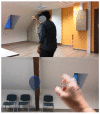Influence of a Three-Month Mixed Reality Training on Gait Speed and Cognitive Functions in Adults with Intellectual Disability: A Pilot Study
- PMID: 38544083
- PMCID: PMC10976226
- DOI: 10.3390/s24061821
Influence of a Three-Month Mixed Reality Training on Gait Speed and Cognitive Functions in Adults with Intellectual Disability: A Pilot Study
Abstract
People with intellectual disability (ID) are often subject to motor impairments such as altered gait. As gait is a task involving motor and perceptive dimensions, perceptual-motor training is an efficient rehabilitation approach to reduce the risk of falls which grows with age. Virtual, augmented, and mixed reality are recent tools which enable interaction with 3D elements at different levels of immersion and interaction. In view of the countless possibilities that this opens, their use for therapeutic purposes is constantly increasing. Therefore, the aim of this study was to investigate the influence a mixed reality activity could have on motor and cognitive abilities in eighteen adults with intellectual disability. For three months, once a week, they had around 20 min to pop virtual balloons with a finger using a Microsoft HoloLens2® head-mounted mixed-reality device. Motor skills were assessed through gait analysis and cognitive abilities were measured with the Montréal Cognitive Assessment. Both walking speed and cognitive score increased after training. In conclusion, this study demonstrates that mixed reality holds potential to get used for therapeutic purposes in adults with ID.
Keywords: cognitive assessment; gait; intellectual disability; mixed reality; perceptual-motor task; virtual reality.
Conflict of interest statement
The authors declare no conflicts of interest.
Figures



Similar articles
-
V-TIME: a treadmill training program augmented by virtual reality to decrease fall risk in older adults: study design of a randomized controlled trial.BMC Neurol. 2013 Feb 6;13:15. doi: 10.1186/1471-2377-13-15. BMC Neurol. 2013. PMID: 23388087 Free PMC article. Clinical Trial.
-
Effects of robot-assisted gait training combined with virtual reality on motor and cognitive functions in patients with multiple sclerosis: A pilot, single-blind, randomized controlled trial.Restor Neurol Neurosci. 2020;38(2):151-164. doi: 10.3233/RNN-190974. Restor Neurol Neurosci. 2020. PMID: 32333564 Clinical Trial.
-
A multi-modal virtual reality treadmill intervention for enhancing mobility and cognitive function in people with multiple sclerosis: Protocol for a randomized controlled trial.Contemp Clin Trials. 2020 Oct;97:106122. doi: 10.1016/j.cct.2020.106122. Epub 2020 Aug 26. Contemp Clin Trials. 2020. PMID: 32858229
-
Treadmill training with virtual reality to enhance gait and cognitive function among people with multiple sclerosis: a randomized controlled trial.J Neurol. 2023 Mar;270(3):1388-1401. doi: 10.1007/s00415-022-11469-1. Epub 2022 Nov 11. J Neurol. 2023. PMID: 36357586 Free PMC article. Clinical Trial.
-
Gait characteristics in individuals with intellectual disabilities: a literature review.Res Dev Disabil. 2014 Nov;35(11):2858-83. doi: 10.1016/j.ridd.2014.07.017. Epub 2014 Aug 7. Res Dev Disabil. 2014. PMID: 25105568 Review.
References
-
- American Psychiatric Association . Diagnostic and Statistical Manual of Mental Disorders. 5th ed. American Psychiatric Association; Washington, DC, USA: 2013. - DOI
MeSH terms
LinkOut - more resources
Full Text Sources
Research Materials

